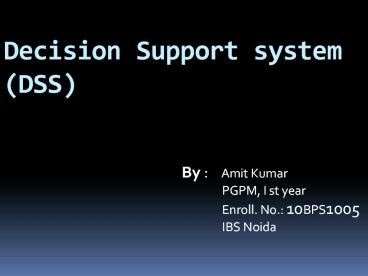Capital Market
Title:
Capital Market
Description:
Capital Market concepts – PowerPoint PPT presentation
Number of Views:548
Title: Capital Market
1
Decision Support system (DSS)
- By Amit Kumar
- PGPM, I st year
- Enroll. No. 10BPS1005
- IBS Noida
2
Definition
- Decision support Systems are computer-based
information systems that supports the decision
making activities of the organization. - A properly designed DSS is an interactive
software-based system intended to help decision
makers compile useful information from a
combination of raw data, documents, personal
knowledge, or business models to identify and
solve problems and make decisions.
3
Typical informations that a decision support
application might gather and present are
- Inventories of all of your current information
assets (including legacy and relational data
sources, cubes, data warehouses, and data marts), - Comparative sales figures between one week and
the next, - Projected revenue figures based on new product
sales assumptions.
4
Examples of DSS
- The Clinical decision support system for medical
diagnosis - A bank loan officer verifying the credit of a
loan applicant or an engineering firm that has
bids on several projects and wants to know if
they can be competitive with their costs. - A specific example concerns the Canadian National
Railway system, which tests its equipment on a
regular basis using a decision support system. A
problem faced by any railroad is worn-out or
defective rails, which can result in hundreds of
derailments per year. Under a DSS, CN managed to
decrease the incidence of derailments at the same
time other companies were experiencing an
increase.
5
Types of DSS
- Communication-driven DSS- supports more than one
person working on a shared task examples include
integrated tools like Microsoft's NetMeeting. - Data-driven DSS or data-oriented DSS-
emphasizes access to and manipulation of a time
series of internal company data and, sometimes,
external data. - Document-driven DSS- manages, retrieves, and
manipulates unstructured information in a variety
of electronic formats. - Knowledge-driven DSS -provides specialized
problem-solving expertise stored as facts, rules,
procedures, or in similar structures. - Model-driven DSS- emphasizes access to and
manipulation of a statistical, financial,
optimization, or simulation model. Model-driven
DSS use data and parameters provided by users to
assist decision makers in analyzing a situation
they are not necessarily data-intensive
6
Characteristics of a DSS
- Handles large amounts of data from different
sources. - Provides report and presentation flexibility.
- Offers both textual and graphical orientation.
- Performs complex, sophisticated analysis and
comparisons using advanced software packages. - Performs different types of analyses
- What-if analysis
- Makes hypothetical changes to problem and
observes impact on the results - Simulation
- Duplicates features of a real system
- Goal-seeking analysis
- Determines problem data required for a given
result
7
Capabilities of a DSS
- Supports
- Problem solving phases
- Different decision frequencies
How many widgets should I order?
Merge with another company
Low
High
Frequency
8
Continued..
- Highly structured problems
- Straightforward problems, requiring known facts
and relationships. - Semi-structured or unstructured problems
- Complex problems wherein relationships among data
are not always clear, the data may be in a
variety of formats, and are often difficult to
manipulate or obtain
9
Components of a DSS
- Model management software (MMS)
- Coordinates the use of models in the DSS
- Model base
- Provides decision makers with access to a variety
of models and assists them in decision making(
models may be Financial models, Statistical
analysis models, Graphical models, Project
management models) - Dialogue manager
- Allows decision makers to easily access and
manipulate the DSS
10
Block Diagram showing Components of DSS
- .
DBMS
MMS
Database
Model Base
External Database
Access to the internet, other networks and other
computer systems
External Database Access database
Dialogue Manager
11
Benefits of DSS
- Improves personal efficiency
- Expedites problem solving (speed up the progress
of problems solving in an organization) - Promotes learning or training
- Increases organizational control
- Creates a competitive advantage over competition
- Encourages exploration and discovery on the part
of the decision maker - Reveals new approaches to thinking about the
problem space - Helps automate the managerial processes.
12
Applications of DSS
- Used in Business organizations to provide support
in activities such as financial planning,
forecasting, risk assessment etc. - Clinical decision support system for medical
diagnosis - DSS are also prevalent in forest management where
the long planning time frame demands specific
requirements
13
Thank you




